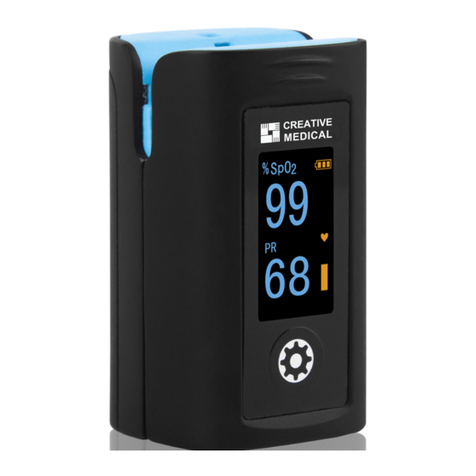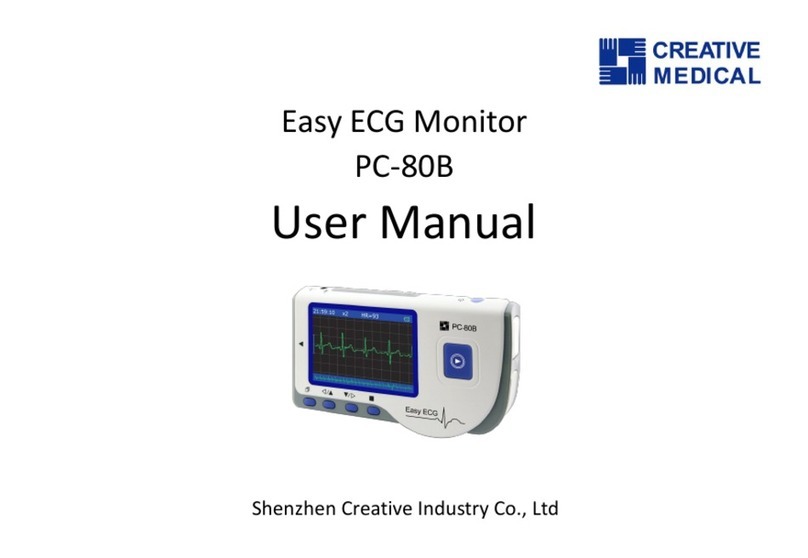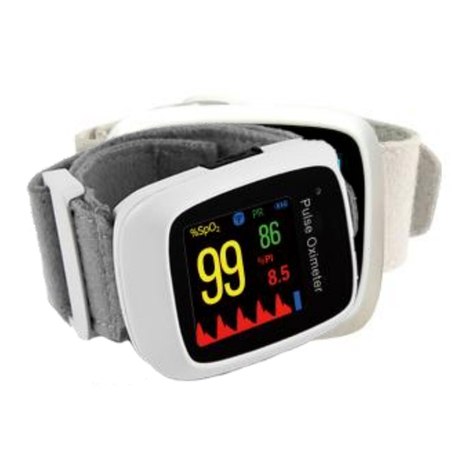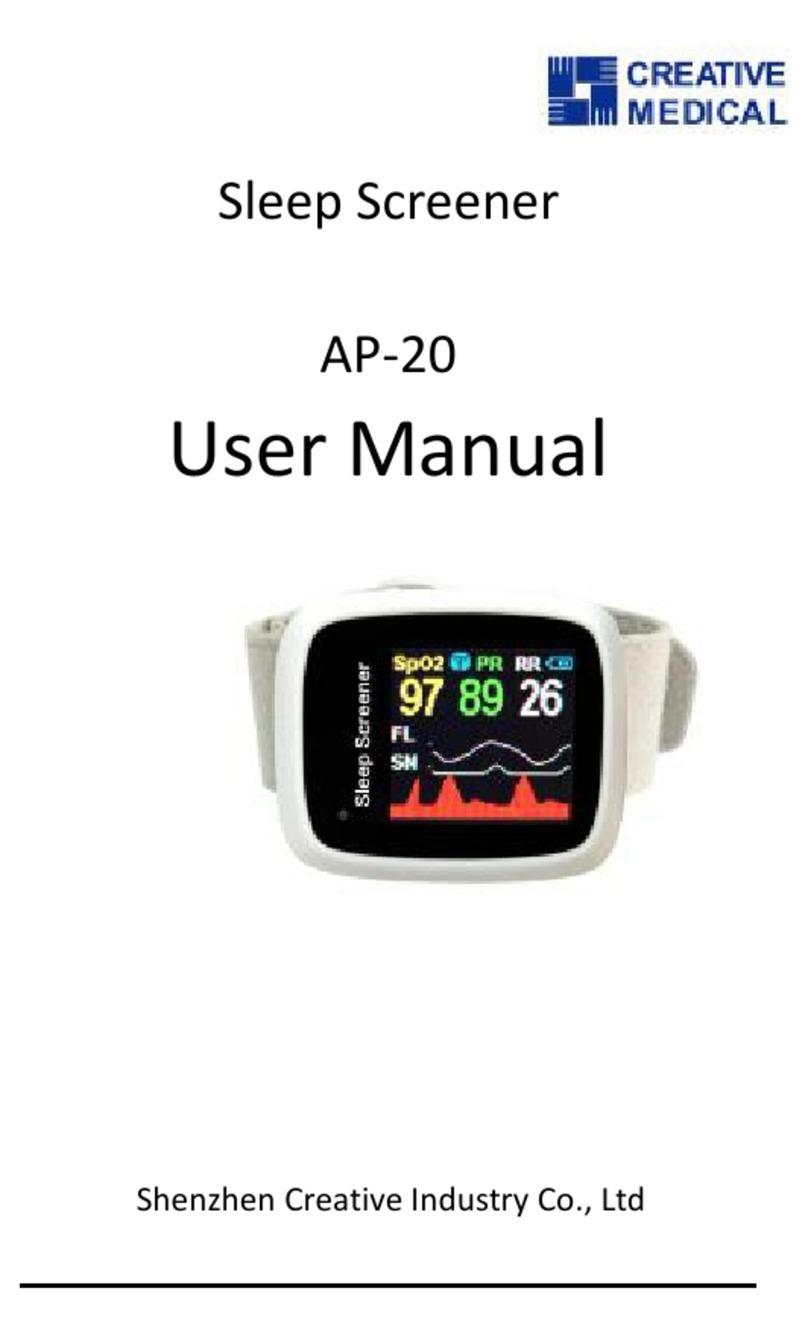Creative Medical PC-60B1 User manual

Fingertip Oximeter
PC-60B1
User Manual
Shenzhen Creative Industry Co., Ltd.

I
Instructions to User
Dear Customers,
Thank you for purchasing this quality product.
Please read the manual very carefully before using
this device. Failure to follow these instructions
can cause measuring abnormality or damage to
the Oximeter.
The manual is published in English and we have
the ultimate right to explain the Manual. No part
of this manual may be photocopied, reproduced
or translated into another language without the
prior written consent. We reserve the right to
improve and amend it at any time without prior
notice.
Version of the Manual: Ver 1.1
Revised date: July 14th , 2019
All rights reserved.
3502-1290147

II
Notes
The contents contained in this manual are
subject to change without notice.
Information furnished by our company is
believed to be accurate and reliable. However,
no responsibility is assumed by us for its use, or
any infringements of patients or other rights of
third parties that may result from its use.
Instructions for Safe Operation
Check the device to make sure that there is no
visible damage that may affect user ’s safety or
measurement performance with regard to
sensors and clips. It is recommended that the
device should be inspected minimally before
each use. If there is obvious damage, stop
using the device.
Special attention should be paid while the
oximeter is used constantly under the ambient
temperature over 37°C, burning hurt may

III
occur because of over-heating of the sensor at
this situation.
Necessary maintenance must be performed
only by qualified service technicians. Users are
not permitted to service this device.
The Oximeter must not be used with devices
and accessories not specified in User Manual.
Cautions
Explosive hazard—DO NOT use the Oximeter
in environment with inflammable gas such as
some ignitable anesthetic agents.
DO NOT use the Oximeter while the patient is
under MRI or CT scanning. This device is NOT
MRI Compatible.
Warnings
Discomfort or pain may appear if using the
Oximeter continuously on the same location
for a long time, especially for patient with
poor microcirculation. It is recommended that

IV
the Oximeter should not be applied to the
same location for longer than 2 hours. If any
abnormal condition is found, please change
the position of Oximeter.
DO NOT clip this device on edema or tender
tissue.
The light (the infrared light is invisible)
emitted from the device is harmful to the eyes.
Do not stare at the light.
The oximeter is not a treatment device.
Local laws and Regulations must be followed
when disposing of the device.
Attentions
Keep the Oximeter away from dust, vibration,
corrosive substances, explosive materials, high
temperature and moisture.
The device should be kept out of the reach of
children.

V
If the Oximeter gets wet, please stop using it
and do not resume operation until it is dry and
checked for correct operation. When it is
carried from a cold environment to a warm
and humid environment, please do not use it
immediately. Allow at least 15 minutes for
Oximeter to reach ambient temperature.
DO NOT operate the button on the front panel
with sharp materials or sharp point.
DO NOT use high temperature or high pressure
steam disinfection on the Oximeter. Refer to
Chapter 7 for instructions regarding cleaning
and disinfection.
The equipment is IP22 with protection against
harmful solid foreign objects and ingress of
liquid. So that means the equipment is
protected against solid foreign objects of
12.5mm and greater, and protected against

VI
vertically falling water drops when enclosure
tilted up to 15°.
Please pay attention to the effects of lint, dust,
light (including sunlight), etc.

VII
Declaration of Conformity
The manufacturer hereby declares that this device
complies with the following standards:
IEC 60601-1: 2005 Medical electrical
equipment-Part 1: General requirements for basic
safety and essential performance;
BS/EN/ISO 9919:2009 or the equivalent ISO
80601-2-61:2011 - Medical electrical equipment --
Part 2-61: Particular requirements for basic safety
and essential performance of pulse oximeter
equipment.
And it also follows the provisions of the council
directive MDD 93/42/EEC.
Caution: U.S. federal law restricts this device
to sale or use by or on the order of a physician.

VIII
Table of Contents
1 OVERVIEW................................................................. 1
1.1 APPEARANCE.......................................................... 1
1.2 NAME AND MODEL................................................ 2
1.3 INTENDED USE........................................................ 2
1.4 FEATURE LIST.......................................................... 2
2 BATTERY INSTALLATION.......................................... 3
3 OPERATION................................................................4
4 TECHNICAL SPECIFICATIONS.................................12
5 REPAIR AND MAINTENANCE................................ 15
5.1 MAINTENANCE......................................................15
5.2 CLEANING AND DISINFECTING INSTRUCTION......... 17
6 TROUBLESHOOTING...............................................18
7 PACKING LIST.......................................................... 19
8 KEY OF SYMBOLS.................................................... 19
9 FREQUENTLY ASKED QUESTIONS........................ 21

1
1 Overview
1.1 Appearance
Figure 1 Front View
Figure 2 Rear View
Rubber Cushions
Display Key
Nameplate
Lanyard Hole
Battery Cover
Display Screen
Lock button of
battery cover

2
1.2 Name and Model
Name: Fingertip Oximeter
Model: PC-60B1
1.3 Intended Use
This Fingertip Oximeter is intended for measuring
the pulse rate and functional oxygen saturation
(SpO2) through a patient ’s finger. It is applicable
for spot-checking SpO2and pulse rate of adult and
pediatric patients in homes and medical clinics.
1.4 Feature List
Large true color OLED display of SpO2, PR and
pulse plethysmogram.
PI display is available
Innovative 4 directions display
Automatic power on/off
Note: the appearance is for demonstration only,
please refer to the oximeter you purchased.

3
Audible & visible over0limit indication
Setting menu is available
Shift parameter display between PR and PI
2 AAA alkaline batteries with low power
consumption
Low battery voltage indication
2 Battery Installation
Figure 3 Battery Installation
1. Refer to Figure 3, insert two AAA size batteries
into the battery compartment properly, and

4
note the polarity markings.
2. Replace the cover.
Please make sure that the batteries are
correctly installed. Incorrect installation may
cause the device not to work.
Please remove batteries if the device is not
being used for more than 7 days to prevent and
avoid potential damage from the battery leaking.
Any such damage is not covered under the
product warranty.
3 Operation
1. Open the clip as shown in figure 3.
Figure 4 Put finger into the Oximeter

5
2. Put finger inside the rubber cushions of the
clip (make sure the finger is in the correct
position), and then clip the finger.
3. The device will power on automatically in 2
seconds, and start to display software version
number.
4. Then the device enter into data display screen,
as shown in figure 5. The user can read the
values and view then waveform from display
screen.
Figure 5 Default measuring screen
Pulse rate value
Pulse rate
label
Pulse strength
bar-graph
Pulse beat icon
SpO2value
SpO2label
Battery voltage

6
For PC-60B1, when short time press Display
Key to change display direction, PI value will
automatically display on the device instead of PR
value, PR value will restore after 20 seconds.
Please refer to figure 6~9 for the oximeter with 4
display directions and PI display.
Figure 6
Figure 7

7
Figure 8
Figure 9
5. Long time press Display key to enter into the
Setup Menu screen, as shown in figure 10.

8
Figure 10
SpO2alm Lo: SpO2low limit setting; range:
85%~99%, the step is 1%. The factory default
value 85%.
PR alm Hi: High limit setting of pulse rate;
range: 100~240bpm, the step is 5bpm. The
factory default value is 120bpm.
PR alm Lo: Low limit setting of pulse rate;
range: 30~60bpm, and the step is 1bpm. The
factory default value for is 50bpm.

9
Save, exit menu: Move the setting item to
“Save, exit menu”, and long time pressing
Display Key to store the modification and exit
from the setup menu.
Restore default: Move the setting item to
“Restore default ”, and long time pressing
Display Key to restore to default setting.
Menu setup:
Short time press Display Key to choose the setting
item; Longtime press Display Key to active the
setting item, then short time press it to modify
the setting parameter; Next, longtime press
Display Key to confirm the modification and exit
from this setting item. At last, move the setting
item to “Save, exit menu”, and long time pressing
Display Key to store the modification and exit
from the setup menu.
Attention to the operation
The finger should be put into the sensor

10
correctly.
Do not shake the finger and relax during
measurement.
Do not put wet finger directly into sensor.
Avoid placing the device on the same limb
which is wrapped with a cuff for blood
pressure measurement or during venous
infusion.
Do not let anything block the emitting light
from device, i.e. do not use finger nail
polish/paints.
Vigorous exercise and electrosurgical device
interference may affect the measuring
accuracy.
The orientation-sensor works on the basis of
the gravity. A small movable metal ball is
built in the orientation-sensor for detecting
the orientation of the oximeter. When you
want to change the oximeter’s display

11
direction, if you move the Oximeter too
slowly, the movable metal ball will also move
slowly because of not enough acceleration.
Consequently the response of orientation
detection would be delayed. Acceleration
needs to be provided to the
orientation-sensor for quick sensing the
orientation change.
Nail polish may affect the measuring
accuracy, and too long fingernail may cause
failure of measurement or inaccurate result.
Existence of high intensive light sources,
such as fluorescence light, ruby lamb,
infrared heater or strong sunshine, etc. may
cause inaccuracy of measurement result.
Please put an opaque cover on the sensor or
change the measuring site if necessary.
If the first reading appears with poor
waveform (irregular or not smooth), then
the reading is unlikely true, the more stable
Table of contents
Other Creative Medical Medical Equipment manuals

Creative Medical
Creative Medical POD-1a User manual

Creative Medical
Creative Medical PC-60F User manual

Creative Medical
Creative Medical POD-1a User manual

Creative Medical
Creative Medical PC-80B User manual

Creative Medical
Creative Medical AP-10 User manual

Creative Medical
Creative Medical AP-20 User manual
Popular Medical Equipment manuals by other brands

Getinge
Getinge Arjohuntleigh Nimbus 3 Professional Instructions for use

Mettler Electronics
Mettler Electronics Sonicator 730 Maintenance manual

Pressalit Care
Pressalit Care R1100 Mounting instruction

Denas MS
Denas MS DENAS-T operating manual

bort medical
bort medical ActiveColor quick guide

AccuVein
AccuVein AV400 user manual











